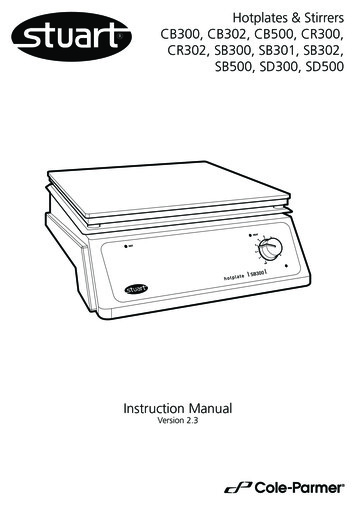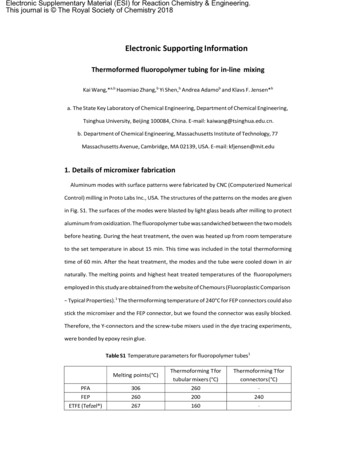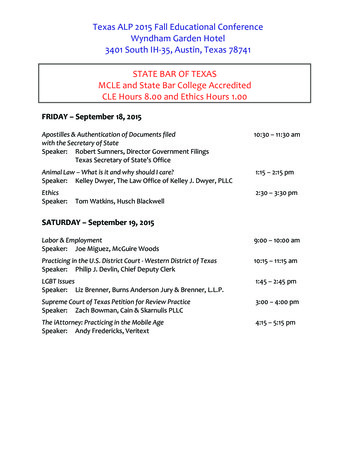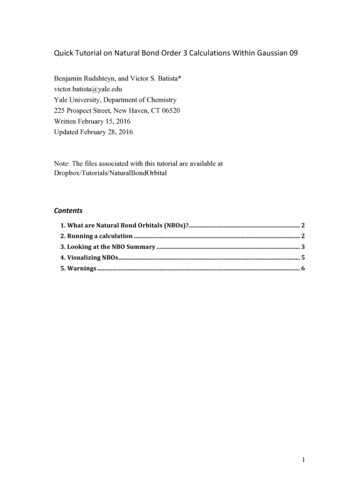
Transcription
Hotplates & StirrersCB300, CB302, CB500, CR300,CR302, SB300, SB301, SB302,SB500, SD300, SD500Instruction ManualVersion 2.3
EnglishBefore UseElectrical InstallationThank you for purchasing this Stuartproduct. To get the best performance fromthe equipment, and for your own safety,please read these instructions carefullybefore use.If the equipment is not used in the mannerdescribed in this manual the protectionprovided may be impaired.This equipment is designed to operate under thefollowing conditions: For indoor use onlyUse in a well ventilated areaAmbient temperature range 5 C to 40 CAltitude to 2000mRelative humidity not exceeding 80%Mains supply fluctuation not exceeding 10%Overvoltage category II IEC60364-4-443Pollution degree 2 IEC664Use with a minimum distance all around of200mm from walls or other itemsBefore connection please read andunderstand this instruction manual andensure that the line supply corresponds tothat shown on the rating plate. All modelsrequire a supply rated at: 230V, 50Hz, ,single phase.Power consumption 3021200W1250W2250W900W950WTHIS INSTRUMENT MUST BE EARTHEDAll models are supplied with two mains leadsfitted with IEC plugs for connection to theinstrument. One has a U.K. 3 pin plug and theother has a 2 pin “Schuko” plug for connectionto the mains. Choose the lead appropriate foryour electrical installation and discard the other.Should neither lead be suitable, take the leadwith the U.K. plug and replace the plug with asuitable alternative. This involves cutting off themoulded plug, preparing the cable andconnecting to the rewireable plug in accordancewith its instructions.IT IS IMPORTANT THAT THIS OPERATIONSHOULD ONLY BE UNDERTAKEN BY AQUALIFIED ELECTRICIANNOTE: Refer to the equipment’s rating plate toensure that the plug and fusing are suitable forthe voltage and wattage stated.2
The wires in the mains cable are coloured asfollows:BROWN- LIVEBLUE- NEUTRALGREEN/YELLOW - EARTHThe instruments are fitted with an IEC socket atthe rear of the instrument for connection of themains lead. The appropriate mains lead should beconnected BEFORE connection to the mainssupply.Should the mains lead need replacement a cableof 1mm2 of harmonised code H05W-F connectedto an IEC320 plug should be used.N.B. The UK mains lead is protected by a 10Afuse mounted in the plug top.IF IN DOUBT CONSULT A QUALIFIEDELECTRICIANWhen connected to the mains electricity supply agreen light on the front panel illuminates, exceptfor the digital SD300 and SD500 models wherethe display will illuminate showing the word“OFF”.Safety Advice Before Use If the mains supply is interrupted the units willrestart with its current settings on therestoration of the electricity supply. Do not use an instrument with a ceramic topif the top plate is scratched, chipped or showssigns of chemical etching. Position the instrument on a firm level surfaceaway from any heat sensitive or flammablematerial. Do not use the units with flammable liquidsor in a hazardous atmosphere. There is a danger of liquid spills if vessels arestirred too vigorously. Always build stirrerspeed slowly and never stir faster thannecessary. Never move or carry the instrument until ithas been switched off and allowed to cool. Never move or carry the unit with containerson the top plate or while the instrument isconnected to the mains electricity supply.3Hot SurfacesWARNING: The top surface of theinstrument may be HOT. Do not leaveheaters switched on when not in use.WARNING: When the surface becomestoo hot to touch the red "HOT" warninglight on the front panel will begin to flash.This will continue to flash while the platetemperature is above 50 C even if the unitis switched off as long as it is connectedto the electricity supply.WARNING: Do not disconnect or switchoff the electricity supply until the “HOT”warning light has ceased flashing.WARNING: The plate may still be hotwhen large masses are left on the plate,even though the "HOT" warning light hasgone out.WARNING: The top surface of theinstrument may be HOT, especially in freeair when a surface temperature of up to450 C can be achieved on some of theceramic top models and 300 C on themetal top models.HeatingModels SB300, SB302, SB500, CB300, CB302,CB500:The knob labelled “Heat” on the front panelcontrols the heat output and hence the platetemperature.The knob is graduated from 1 - 9. Increasing thevalue increases the heat output.Turn the hotplate control knob clockwise to thedesired setting. The amber load indicator lightwill illuminate and it will begin to cycle on andoff when the desired temperature is reached andthe hotplate begins to control.Models SD300 and SD500:When connected to the mains electricity supplythe digital display will illuminate and show theword OFF.
Switch the unit on by pressing the left hand oneof the 2 buttons located to the left of the digitaldisplay. The display will now show the actualplate temperature in degrees Celsius.Press and hold the “press to set” button, theright hand one of the 2 buttons located to theleft of the digital display. The display will nowshow the set temperature.The set temperature may be adjusted by turningthe knob located to the right of the digitaldisplay whilst continuing to hold in the “press toset” button. When the desired setting isdisplayed release the “press to set” button. Thedisplay will revert to show the actual platetemperature and the instrument will begin toheat.The set temperature can be observed at any timeby pressing the “press to set” button.Turning the adjusting knob without pressing the“press to set” switch will have no effect on thehotplate setting.Models CR300 and CR302:The knob labelled “Heat” on the front panelcontrols the heat output and hence the platetemperature. When the heat is switched on theamber pilot light illuminates.The knob is graduated from 1 - 9. Increasing thevalue increases the heat output.In operation only the area defined by the patternwill become fully heated. The outer edges remaincooler for safety considerations.Vessels larger than the described area should notbe used. Failure to observe this could give rise tooverheating of the outer parts of the instrument.NOTE: To prevent overheating of theinfrared heater a temperature limiter isfitted which switches off the heater shouldthe temperature exceed 580 C.4StirringModels SB301, SB302, CB302 and CR302:The knob labelled “Stir” on the front panelcontrols the stirrer speed.It is labelled with an arbitrary numeric scale,1 - 9 and turning the knob to a higher settingincreases stirrer speed.When the stirrer is switched on the amber pilotlight illuminates.Cleaning and CareBefore attempting cleaning disconnect from themains electricity supply and ensure that the top iscool.Periodically clean the body of the instrumentusing a damp cloth and mild detergent solution.Do not use harsh or abrasive cleaning agents.Ceramic top models: The ceramic top is veryeasy to keep clean. A damp cloth will normallyremove most types of contamination. For moredifficult stains a domestic cream cleanser isrecommended. Cleaning is made easier ifspillages are attended to promptly. In any case,spillages of alkali, phosphoric acid andhydrofluoric acid MUST be removed immediatelyas these chemicals can attack and damage theglass ceramic. Ensure that the appropriate safetyprecautions are observed.During cleaning and general operation take carenot to scratch the surface of the top plate as thiscould result in subsequent thermal breakage.WARNING: A ceramic top which isscratched, chipped, chemically etched ordamaged must not be used.Metal top models: The metal top plates shouldbe cleaned using a damp cloth and milddetergent solution. Do not use harsh or abrasivecleaning agents. Cleaning is made easier ifspillages are attended to promptly. In any case,spillages of acids and alkalis MUST be removedimmediately as these chemicals can attack anddamage the aluminium alloy. Ensure that theappropriate safety precautions are observed.
Servicing and RepairWarrantyThis product range does not require any routineservicing.Cole-Parmer Ltd. warrants these instruments tobe free from defects in material andworkmanship, when used under normallaboratory conditions, for a period of three (3)years. In the event of a justified claimCole-Parmer will replace any defectivecomponent or replace the unit free of charge.Note: There are no internal userreplaceable partsIn the event of product failure any repair orreplacement of parts should only be undertakenby suitably qualified personnel. For advice pleasecontact the Service Department of Cole-Parmerquoting model and serial number.Only spare parts supplied or specified byCole-Parmer or its agents should be used. Fittingof non-approved parts may affect theperformance of the safety features designed intothe instrument.Note: The magnetic stirrer drive utilisesstrong magnets.If in any doubt, please contact the ServiceDepartment of Cole-Parmer or the point of sale.Cole-Parmer Ltd.Beacon Road,Stone, Staffordshire,ST15 0SA, United KingdomTel: 44 (0)1785 810475Email: cpservice@coleparmer.comWeb: www.stuart-equipment.com5This warranty does NOT apply if damage iscaused by fire, accident, misuse, neglect,incorrect adjustment or repair, damage caused byinstallation, adaptation, modification, fitting ofnon approved parts or repair by unauthorisedpersonnel.
FrançaisAvant utilisationInstallation électriqueAvant de procéder au branchement,prenez le temps de lire et comprendre cemanuel d’instructions et assurez-vous quel’alimentation de la ligne correspond àcelle indiquée sur la plaque signalétique.Tous les modèles nécessitent unealimentation nominale de 230V, 50Hz, ,monophasée.Si le matériel n’est pas utilisé de la manièredécrite dans le présent manuel, la protectionfournie risque d’être amoindrie.Ce matériel est conçu pour fonctionner dans lesconditions suivantes : Utilisation en intérieur uniquement Utilisation dans une zone bien ventilée Plage de températures ambiantesde 5 C à 40 C Altitude jusqu’à 2000m Humidité relative ne dépassant pas 80% Fluctuations d’alimentation secteur nedépassant pas 10% de la tension nominale Surtension de catégorie II IEC 60364-4-443 Pollution de degré 2 IEC664La puissance consommée est R302Puissance1200W1250W2250W900W950WCE MATERIEL DOIT ETRE RELIE A LATERRETous les modèles sont livrés avec deux cordonssecteur équipés de prises IEC à connecter àl’instrument. L’un présente une fiche britanniqueà 3 broches et l’autre possède une fiche“Schuko” à 2 broches pour le branchement sursecteur. Choisir le cordon approprié pour votreinstallation électrique et jeter l’autre.Si ni l’un ni l’autre ne convient, prendre le cordonéquipé de la fiche britannique et remplacer cettefiche par une prise de remplacement adaptée.Ceci implique de couper la fiche moulée,préparer le câble et le connecter à la fiche àmonter, en conformité avec les instructions decette dernière.IL EST IMPORTANT QUE CETTE OPERATIONNE SOIT EFFECTUEE QUE PAR UNELECTRICIEN QUALIFIENOTE : Se reporter à la plaque signalétique dumatériel pour vérifier que la fiche et le fusibleconviennent à la tension et à la puissanceindiquées.6
Les fils du câble secteur ont les couleurs suivantes:MARRON- PHASEBLEU- NEUTREVERT/JAUNE- TERRELes instruments sont équipés d’une prise IEC àl’arrière de l’instrument pour le branchement ducordon secteur. Le cordon secteur appropriédevra être connecté AVANT branchement àl’alimentation au secteur.Si le cordon secteur doit être remplacé, un câblede 1mm2 au code harmonisé H05W-F connecté àune fiche IEC 320 devra être utilisé.N.B. : Le cordon secteur britannique est protégépar un fusible 10A monté sur le haut de la fiche.EN CAS DE DOUTE, CONSULTER UNELECTRICIEN QUALIFIEUne fois l’instrument branché sur à l’alimentationélectrique du secteur, un voyant vert s’allume surle panneau de façade, sauf pour les modèlesnumériques SD300 et SD500 où l’afficheurs’allume en présentant le mot “OFF” (arrêt).Conseils de sécurité avantutilisation Ne jamais déplacer ou transporter l’instrumentsans l’avoir mis hors tension et laissé refroidir. Ne jamais déplacer ou transporter l’appareilavec des récipients sur la plaque supérieure oualors que l’instrument est branché àl’alimentation électrique secteur.Surfaces chaudesAVERTISSEMENT : La face supérieurede l’appareil peut être CHAUDE. Nepas laisser le dispositif de chauffagesous tension lorsque l’appareil n’estpas utilisé.AVERTISSEMENT : Lorsque la surfacedevient brûlante au toucher, le voyantrouge « HOT » présent sur la face avantse met à clignoter. Il continue à clignotertant que la température de la plaque estsupérieure à 50 C, même si l’appareil estmis hors tension, et aussi longtemps qu’ilest relié à l’alimentation électrique.AVERTISSEMENT : Ne pas débrancher oucouper l’alimentation électrique tant quele voyant d’avertissement « HOT »clignote. Si l’alimentation secteur est interrompue, lesappareils redémarreront avec leurs réglagesactuels au rétablissement de l’alimentationélectrique.AVERTISSEMENT : La plaque peut resterchaude lorsque des masses importantessont laissées sur la plaque, et ce, même sile voyant « HOT » est éteint. Ne pas utiliser un instrument comportant undessus en céramique si la plaque supérieureest rayée, écaillée, ou montre des signesd’attaque chimique.AVERTISSEMENT : La face supérieure del’appareil peut être CHAUDE, enparticulier à l’air libre où une températurede surface pouvant aller jusqu’à 450 Cpeut être atteinte sur certains modèlesdotés d’une surface en céramique etjusqu’à 300 C sur les modèles à surfacemétallique. Positionner l’instrument sur une surface stableet de niveau, loin de toute matière sensible àla chaleur ou inflammable. Ne pas utiliser ces appareils avec des liquidesinflammables ou dans une atmosphèredangereuse.Chauffage Il existe un risque de déversement de liquidessi les récipients sont agités tropvigoureusement. Toujours augmenterlentement la vitesse d’agitation et ne jamaisagiter plus vite que nécessaire.La molette étiquetée “Heat” (chaleur) sur lepanneau de façade commande la puissancecalorifique et donc la température de la plaque.Modèles SB300, SB302, SB500, CB300, CB302,CB500 :La molette est graduée de 1 à 9. Augmenter sonréglage fait augmenter la puissance calorifique.7
Tourner la molette de commande de la plaquechauffante dans le sens horaire jusqu’au réglagevoulu. Le voyant indicateur orange de charge vas’illuminer et va commencer à s’allumer ets’éteindre quand la température souhaitée estatteinte et que la plaque chauffante commence àla réguler.gabarit est chauffée à fond. Les bords extérieursrestent plus froids pour des considérations desécurité.Des récipients plus grands que la zone décrite nedevront pas être utilisés. Ne pas respecter cetterègle pourra donner lieu à une surchauffe desparties extérieures de l’instrument.Modèles SD300 et SD500 :Attention! Afin d’éviter toute sur-chauffeéventuelle de la lampe infra-rouge, unlimiteur de température est installé dansl’appareil et coupera le chauffage si cettetempérature excède 580 C.Une fois branché à l’alimentation électriquesecteur, l’afficheur numérique s’allume et indiquele mot OFF.Mettre l’appareil sous tension on appuyant sur lebouton de gauche des 2 boutons situés sur lagauche de l’afficheur numérique. L’afficheur vamaintenant indiquer la température réelle de laplaque en degrés Celsius.Appuyer sur le bouton “press to set” (appuyerpour régler), le bouton de droite des 2 boutonssitués sur la gauche de l’afficheur numérique, etle maintenir enfoncé. L’afficheur va maintenantindiquer la température de consigne.La température de consigne peut être ajustée entournant la molette située sur la droite del’afficheur numérique tout en continuant demaintenir le bouton “press to set”. Une fois leréglage voulu affiché, relâcher le bouton “pressto set”. L’afficheur retourne à l’indication detempérature réelle de la plaque et l’instrument vacommencer à chauffer.La température de consigne peut être observée àtout moment en appuyant sur le bouton “pressto set”.Tourner la molette de réglage sans appuyer sur lacommande “press to set” n’aura aucun effet surle réglage de la plaque chauffante.Modèles CR300 et CR302 :La molette étiquetée “Heat” (chaleur) sur lepanneau de façade commande la puissancecalorifique et donc la température de la plaque.Lorsque l’appareil est sous tension, le voyantpilote range s’allume.La molette est graduée de 1 à 9. Augmenter sonréglage fait augmenter la puissance calorifique.En fonctionnement, seule la zone définie par le8AgitationModèles SB301, SB302, CB302 et CR302 :La molette étiquetée “Stir” (agiter) sur lepanneau de façade commande la vitessed’agitation.Elle est étiquetée à l’aide d’une échellenumérique arbitraire, 1 à 9, et tourner la molettesur un réglage supérieur augmente la vitessed’agitation.Lorsque l’agitateur est sous tension, le voyantpilote orange s’allume.Nettoyage et soinAvant de tenter de nettoyage l’instrument,débrancher l’alimentation électrique secteur ets’assurer que le dessus est FROID.Nettoyer périodiquement le corps de l’instrumentà l’aide d’un chiffon humide et d’une solution dedétergent doux. Ne pas utiliser d’agentsnettoyants durs ou abrasifs.Modèles à dessus céramique : Il est très facilede garder le dessus céramique propre. Un chiffonhumide éliminera normalement la plupart destypes de contamination. Pour des tâches plusdifficiles, une crème à nettoyer domestique estrecommandée. Le nettoyage est facilité si l’ons’occupe rapidement des déversements. Danstous les cas, les déversements de bases, acidephosphorique et acide fluorhydrique DOIVENTêtre éliminés immédiatement car ces produitschimiques peuvent attaquer et endommager la
vitrocéramique. Veiller à respecter les précautionsde sécurité appropriées.En cas de doute, veuillez contacter le Servicetechnique Cole-Parmer ou votre point de vente.Pendant le nettoyage comme en coursd’utilisation en général, prendre soin de ne pasrayer la surface de la plaque supérieure, car celapourrait entraîner par la suite des rupturesthermiques.Cole-Parmer Ltd.Bâtiment le Deltaparc Silic pars Nord 27 rue du CanalBP 55437 Villepinte95944 ROISSY Charles de GaulleFranceTél : 33 1 48 63 77 99Fax : 33 1 48 63 78 01Email : cpservice@coleparmer.comWeb : www.stuart-equipment.frAVERTISSEMENT : Un dessus céramique rayé,écaillé, attaqué par des produits chimiquesou endommagé ne doit pas être utilisé.Modèles à dessus métallique : Les plaquesmétalliques devront être nettoyées à l’aide d’unchiffon humide et d’une solution de détergentdoux. Ne pas utiliser d’agents nettoyants durs ouabrasifs. Le nettoyage est facilité si l’on s’occuperapidement des déversements. Dans tous les cas,les déversements d’acides et bases DOIVENT êtreéliminés immédiatement car ces produitschimiques peuvent attaquer et endommagerl’alliage d’aluminium. Veiller à respecter lesprécautions de sécurité appropriées.Entretien et réparationCette gamme de produits ne nécessite pasd’entretien régulier.Note : Il n’y a pas de pièces internesremplaçables par l’utilisateurEn cas de défaillance du produit, la réparation oule remplacement des pièces ne devront êtreentrepris que par un personnel convenablementqualifié. Pour demander conseil ou recevoir le unmanuel d’entretien, veuillez contacter le Servicetechnique de Cole-Parmer en mentionnant lemodèle et le numéro de série.Seules les pièces détachées fournies parCole-Parmer ou ses agents devront être utilisées.Le montage de pièces non-agréées peut affecterles performances des caractéristiques de sécuritéprévues sur l’instrument.Note : l’entraînement de l’agitateurmagnétique emploie des aimants forts.9GarantieCole-Parmer Ltd. garantit ces instruments commeexempts de défauts de matériaux et de façon, enutilisation dans les conditions normales delaboratoire, pendant une période de trois (3) ans.En cas de réclamation justifiée, Cole-Parmerremplacera gratuitement tout composantdéfectueux.Cette garantie ne s’applique PAS si les dégâts ontété provoqués par un incendie, un accident, unabus d’utilisation, une négligence, un réglage ouune réparation incorrects, ou s’il s’agit de dégâtspar adaptation de l’installation, modification,montage de pièces non-agréées ou la réparationpar un personnel non-autorisé.
ItalianoInformazioni preliminariInstallazione elettricaL’inosservanza delle istruzioni riportate nelpresente manuale può pregiudicare leprotezioni a corredo del prodotto.Prima di effettuare l’allacciamento delprodotto alla rete elettrica, si invitano gliutenti a leggere attentamente il presentemanuale d’uso, nonché a verificare chel’alimentazione elettrica erogatacorrisponda a quella stampigliata sullapiastra riscaldante. Tutti i modellirichiedono i seguenti requisiti dialimentazione: 230 V, 50 Hz, , monofase.L’apparecchio deve essere utilizzatoesclusivamente nelle condizioni indicate qui diseguito: In locali chiusi In ambienti adeguatamente ventilati A temperature ambiente comprese fra 5 C e 40 C Ad altitudine massima di 2000 m In ambienti con umidità relativa inferioreall’80% In presenza di variazioni di corrente inferiori al10% In presenza di sovratensioni di categoria II anorma IEC 60364-4-443 Grado di inquinamento 2 IEC664Il consumo di corrente dei vari modelli è indicatoin R300CR302Potenza1200W1250W2250W900W950WÈ OBBLIGATORIA LA MESSA A TERRADELLO STRUMENTOTutti i modelli vengono forniti con due cavi dialimentazione dotati di spine IEC destinate alcollegamento allo strumento. Uno è dotato dispina a 3 spinotti inglese, l’altra di una spina“Schuko” a 2 spinotti. Scegliere il cavo idoneoper l’allacciamento alla rete elettrica e gettarel’altro.Qualora nessuna delle due spine sia idonea,utilizzare il cavo dotato di spina inglese esostituire la spina; a tal fine, tagliare il cavo,prepararlo e ricollegarlo ad una spina idoneaattenendosi alle istruzioni a corredo.È TASSATIVO AFFIDARE L’ESECUZIONE DIQUESTA OPERAZIONE AD UN ELETTRICISTAQUALIFICATONOTA: Leggere le istruzioni stampigliate sullatarghetta d’immatricolazione per verificare che laspina e il fusibile utilizzati siano idonee per latensione e la potenza indicate sulla targhetta.10
Il codice dei fili è indicato qui di seguito:MARRONE- FASEBLU- NEUTROGIALLO/VERDE - TERRAGli strumenti sono muniti di presa IEC sulpannello posteriore, destinata al collegamentodel cavo di alimentazione. Quest’ultimo deveessere inserito in questa presa PRIMA di inserirlonella presa di rete.Qualora si debba sostituire il cavo dialimentazione, utilizzare un cavo da 1mm2 concodice armonizzato H05W-F collegato a unaspina IEC 320.N.B. Il cavo di alimentazione per il mercatoinglese è protetto da un fusibile da 10A montatonella parte superiore della spina.IN CASO DI DUBBIO, RIVOLGERSI A UNELETTRICISTA QUALIFICATOQuando lo strumento viene collegato alla reteelettrica, si accende la spia verde posta sulfrontale dello strumento, ad eccezione deimodelli digitali SD300 e SD500, nei quali siillumina il display e compare la scritta “OFF”.Norme di sicurezza daosservare prima dell’uso In caso di caduta di corrente, al ripristino dellacorrente lo strumento viene riavviato con ivalori selezionati prima della caduta dicorrente. Non utilizzare lo strumento se la base inceramica è graffiata, scheggiata o presentadanni provocati da sostanze chimiche. Sistemare lo strumento su una superficiesolida e piana, lontano da materialitermosensibili o infiammabili. Non utilizzare lo strumento con liquidiinfiammabili o in atmosfere pericolose. La mescolatura eccessiva dei contenitori puòprovocare la fuoriuscita del liquido checontengono. Aumentare gradualmente lavelocità dell’agitatore e non raggiungerevelocità eccessive.11 Prima di movimentare o trasportare lostrumento, spegnerlo e lasciarlo raffreddare. Prima di movimentare o trasportare lostrumento, togliere gli eventuali contenitoripoggiati sulla piastra e staccare lo strumentodalla presa di corrente.Superfici caldeATTENZIONE: La superficie superioredello strumento potrebbe essereCALDA. Non lasciare le piastreriscaldanti accese quando nonvengono utilizzate.ATTENZIONE: Quando la superficiediventa troppo calda per essere toccata, laspia di avvertenza temperatura elevata"HOT" inizia a lampeggiare sul pannellofrontale. Con l'unità spenta ma ancoracollegata all'alimentazione elettrica,questa spia continua a lampeggiare finchéla temperatura della piastra è superiore a50 C.ATTENZIONE: Non scollegare o spegnerel'alimentazione elettrica finché la spia diavvertenza temperatura elevata "HOT"non ha smesso di lampeggiare.ATTENZIONE: La piastra potrebbe esserecalda quando vi si lasciano sopra oggettidi grandi dimensioni, anche se la spia"HOT" si è spenta.ATTENZIONE: La superficie dellostrumento potrebbe essere CALDA, inparticolare nell'aria ambiente quando lasuperficie raggiunge una temperatura di450 C sui modelli in ceramica, e di 300 Csui modelli in metallo.RiscaldamentoModelli SB300, SB302, SB500, CB300, CB302,CB500:La manopola stampigliata con la scritta “Heat”sul pannello frontale regola il calore erogato equindi la temperatura della piastra.La manopola presenta suddivisioni graduate da 1 a 9.
Maggiore il valore, maggiore il calore erogato.Ruotare la manopola della piastra riscaldante insenso orario al valore desiderato. Quando vieneraggiunta la temperatura desiderata, si accendela spia arancio. Quando la temperatura scende aldi sotto di questo valore, la spia si spegne.Modelli SD300 e SD500:Quando lo strumento viene collegato alla reteelettrica, si illumina il display digitale e appare lascritta OFF.Per accendere lo strumento, agire sul pulsante asinistra dei 2 pulsanti posti a sinistra del displaydigitale. Il display visualizza la temperaturaeffettiva della piastra in gradi centigradi.Premere e tenere premuto il pulsante “press toset”, ovvero il pulsante a destra dei 2 pulsantiposti a sinistra del display digitale. Il displayvisualizza la temperatura prescelta.Per regolare la temperatura prescelta, ruotare lamanopola posta a destra del display digitale etenere nel contempo premuto il pulsante “pressto set”. Quando il valore desiderato appare suldisplay, rilasciare il pulsante “press to set”. Ildisplay visualizza di nuovo la temperaturaeffettiva della piastra riscaldante e lo strumentocomincia a riscaldarsi.La temperatura prescelta può essere verificata inqualsiasi momento agendo sul pulsante “press toset”.La rotazione della manopola di regolazione senzaagire sul pulsante “press to set” non ha alcuneffetto sulla piastra riscaldante.Modelli CR300 e CR302:La manopola con dicitura “Heat” sul pannellofrontale regola il calore erogato e quindi latemperatura della piastra. Quando vieneraggiunta la temperatura desiderata, si accendela spia arancio.La manopola presenta suddivisioni graduate da 1a 9. Maggiore il valore prescelto, maggiore ilcalore erogato.Durante l’uso dello strumento, si riscaldacompletamente soltanto l’area circoscritta dallagrafica. Per motivi di antinfortunistica, i bordiesterni vengono mantenuti ad una temperatura12inferiore.Non utilizzare recipienti più grandi della superficieriscaldata. L’inosservanza di questa normaprecauzionale può provocare il surriscaldamentodelle parti esterne dello strumento.NOTA: per prevenire il surriscaldamentodell’elemento infrarosso riscaldante è statoinserito un limitatore di temperatura chespegne l’elemento riscaldante qualora latemperatura dovesse superare 580 C.AgitatoreModelli SB301, SB302, CB302 e CR302:La manopola con dicitura “Stir” posta sulpannello frontale regola la velocità dell’agitatore.È contrassegnata da una scala numericaarbitraria, da 1 a 9, maggiore il valore presceltosulla manopola, maggiore la velocitàdell’agitatore.L’accensione dell’agitatore viene segnalatadall’accensione della spia arancio.Pulizia dello strumentoPrima di pulire lo strumento, verificare che siadisinserito dalla presa di rete e che la piastra si siaraffreddata.Pulire periodicamente il corpo dello strumentocon un panno umido e una soluzione detergenteneutra. Non usare detergenti troppo acidi oabrasivi.Modelli in ceramica: La piastra in ceramica èfacile da tenere pulita. È sufficiente l’impiego diun panno umido per eliminare lo sporcoordinario. In presenza di sporco ostinato, ricorrereall’impiego di un detergente in crema per usodomestico. Si consiglia di agire tempestivamentesulle macchie e di pulire immediatamente lemacchie provocate dalla fuoriuscita di sostanzealcaline, acido fosforico e acido fluoridrico, ondeevitare che danneggino la ceramica. Attenersiscrupolosamente a queste istruzioni.Durante la pulizia e l’utilizzo dello strumento,avere l’accortezza di non graffiare la base delle
piastre riscaldanti onde evitare la conseguenterottura termica.ATTENZIONE: Non usare una piastra conbase in ceramica che presenta graffi,scheggiature o danni provocati da sostanzechimiche.Modelli con base metallica: Pulire le piastreriscaldanti con base metallica con un pannoumido e una soluzione detergente neutra. Nonusare detergenti troppo acidi o abrasivi. Siconsiglia di agire tempestivamente sulle macchiee di pulire immediatamente le macchie provocatedalla fuoriuscita di sostanze alcaline, acidofosforico e acido fluoridrico onde evitare chedanneggino la ceramica. Attenersiscrupolosamente a queste istruzioni.Manutenzione e riparazioneQuesta linea di prodotti non richiede nessunintervento di manutenzione.Nota: Lo strumento non contieneparti interne sostituibiliIn caso di guasto dello strumento, affidare gliinterventi di riparazione o di sostituzione delleparti esclusivamente a tecnici specializzati. Perinformazioni utili o per richiedere il manuale dimanutenzione, rivolgersi al reparto di assistenzatecnica della Cole-Parmer citando il modello e ilnumero di matric
plate temperature in degrees Celsius. Press and hold the "press to set" button, the . BLEU -NEUTRE VERT/JAUNE - TERRE Les instruments sont équipés d'une prise IEC à l'arrière de l'instrument pour le branchement du cordon secteur. Le cordon secteur approprié CB500 :










